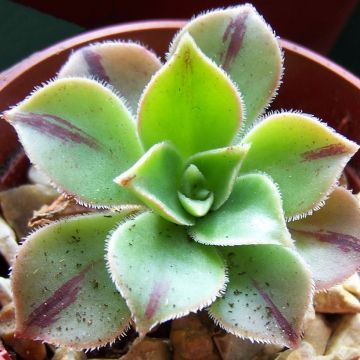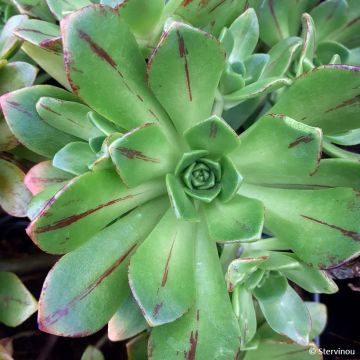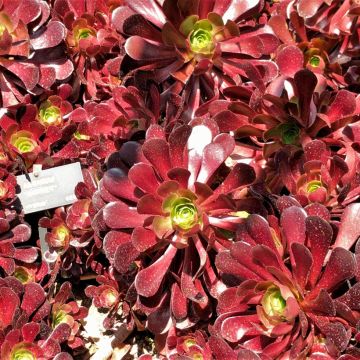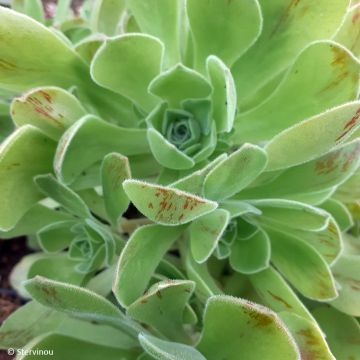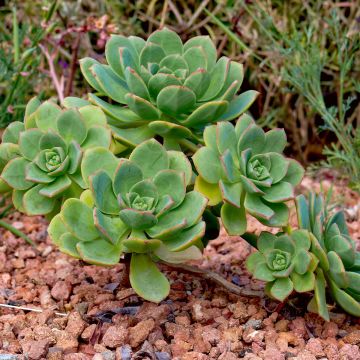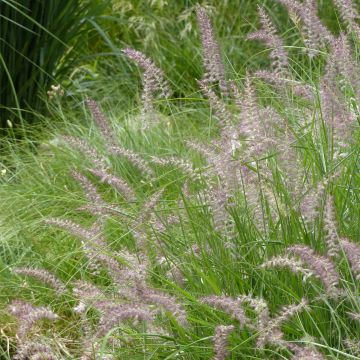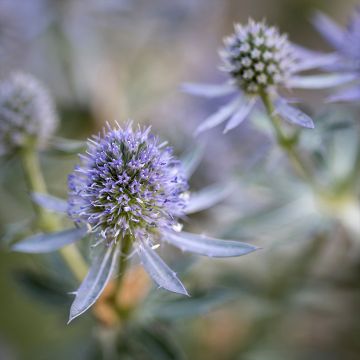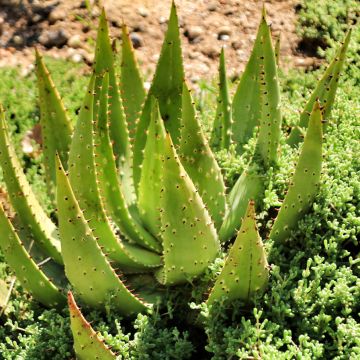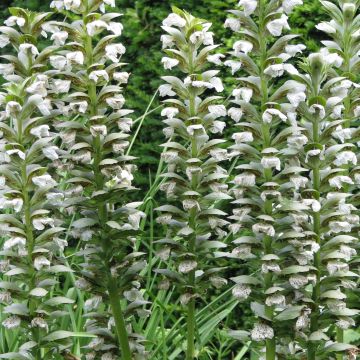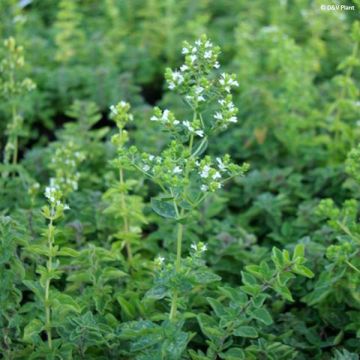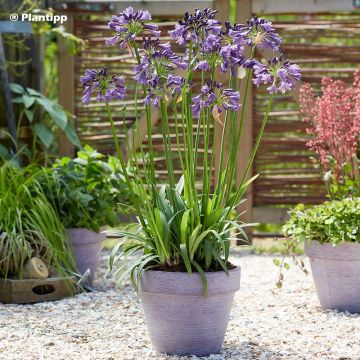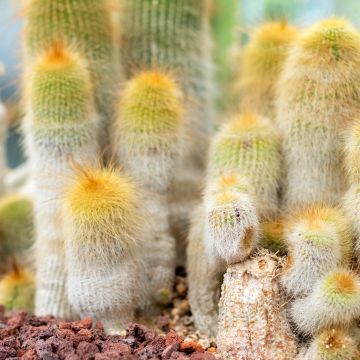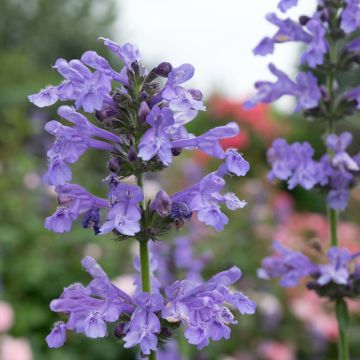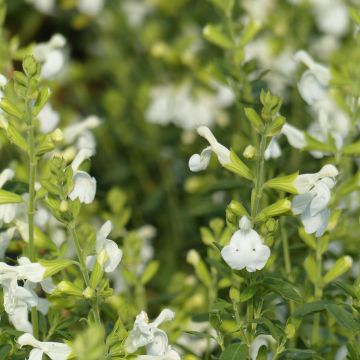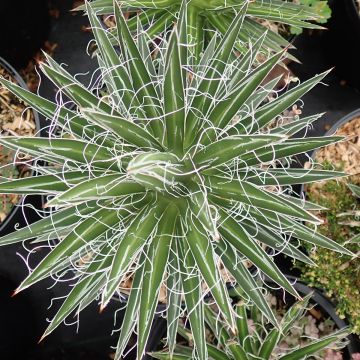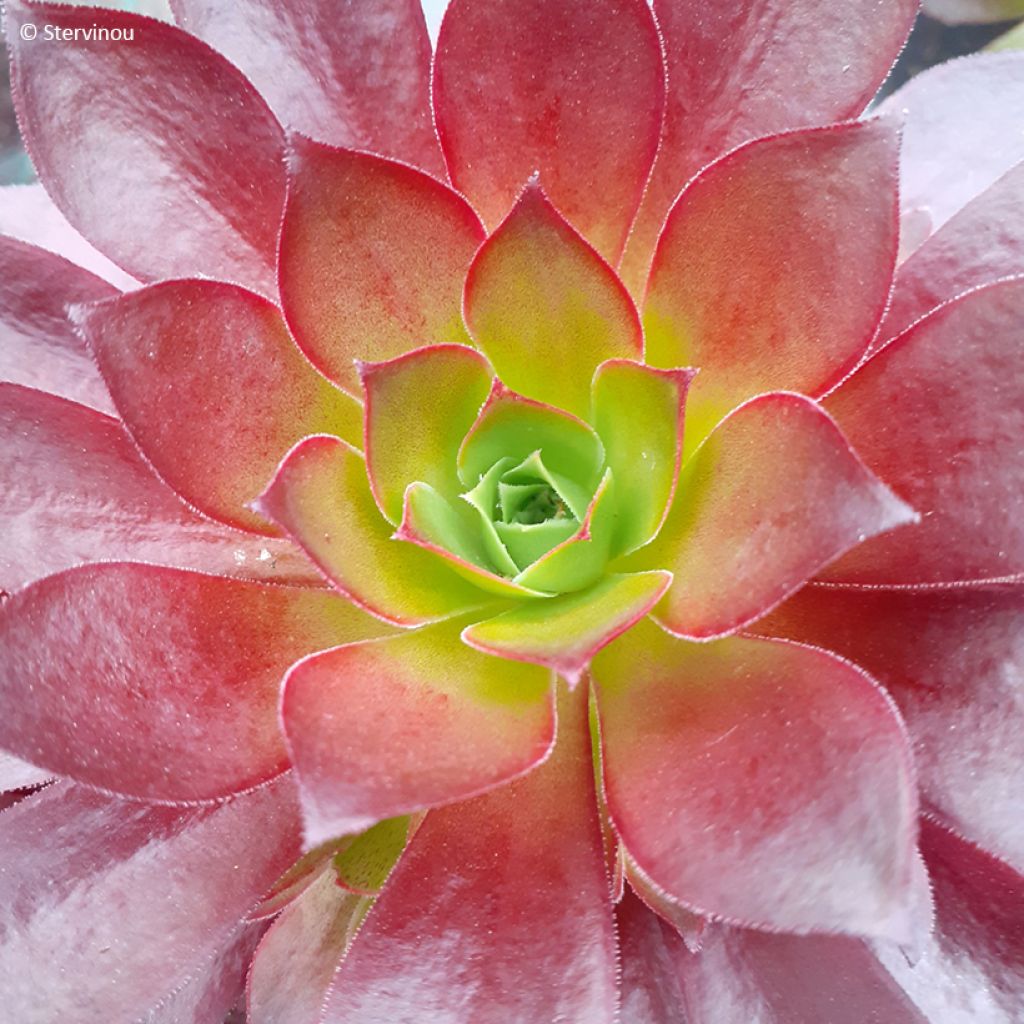

Aeonium arboreum Phoenix Flame - Tree Aeonium
Aeonium arboreum Phoenix Flame - Tree Aeonium
Aeonium arboreum Phoenix Flame
Tree Aeonium, Tree Houseleek, Irish Rose
This item cannot be shipped to the selected country
Delivery charge from €5.90
More information
Schedule delivery date,
and select date in basket
This plant carries a 24 months recovery warranty
More information
We guarantee the quality of our plants for a full growing cycle, and will replace at our expense any plant that fails to recover under normal climatic and planting conditions.
From €5.90 for pickup delivery and €6.90 for home delivery
Express home delivery from €8.90.
Does this plant fit my garden?
Set up your Plantfit profile →
Description
The Aeonium arboreum 'Phoenix Flame' is an extremely ornamental horticultural hybrid. Very compact, it also has the merit of growing rather quickly and branching out extensively, allowing it to form a magnificent clump. The numerous rosettes adopt a geometric shape close to perfection that is as appealing as the color contrast they offer. Their green heart thus highlights the purple of the rest of the foliage, which darkens even further with sunlight. Growing in most well-drained soils, this variety proves hardier than others. It can also be easily grown in pots in colder regions.
The Aeonium is a succulent plant of the Crassulaceae family, rich in about thirty genera and nearly 1400 species. While the walker may come across the Navelwort (Umbilicus) in nature, green roof designers will extensively use the Sedum genus for its drought resistance, as will gardeners. The Kalanchoe in our apartments or the Houseleek in our rockeries are other members of this very distinctive yet diverse family. The 45 Aeonium species, on the other hand, all share a family resemblance, with most originating from the Canary Islands. Their beauty lies as much in their colors as in the geometry of the rosettes they develop.
'Phoenix Flame' is a complex hybrid, resulting from the crossbreeding of Aeonium dodrantale with a hybrid. A. dodrantale is native to the Canary Island of Tenerife, where it grows above 600 m in altitude, on the slopes of the Teide volcano which sometimes receives a bit of snow in winter. A species of medium mountain, this Aeonium prefers partial shade rather than full sun when planted in warm regions. It has the particularity of forming numerous rosettes around the main axis, a genetic trait it passed on to 'Phoenix Flame'. It was crossed with a hybrid involving Aeonium simsii, a species truly from the mountains, adapted to partial shade or shade and hardiest of all, able to withstand fleeting frosts of -10°C! The other parent of this hybrid is the famous horticultural variety 'Zwartkop' with a large development (as a true Aeonium arboreum, it reaches 1.50 m in height) and widely used by breeders for its almost black dark purple color in summer that it readily passes on to its offspring.
Aeonium 'Phoenix Flame' has thus inherited all these qualities, making it a variety of great ornamental interest. Growing rather fast, it branches generously and quickly forms a very dense compact clump, approximately 40 cm in height by 50 cm in spread. It spontaneously forms numerous very geometric rosettes, measuring up to 10 cm in diameter for the largest, in which there is an evocation of the beauty of certain roses and the grace of Leucadendron flowers. Narrow at the base, the leaves gradually widen towards their upper quarter before abruptly narrowing to form a terminal point (non-prickly). The leaf edges are ciliate and while the heart of the rosette remains green, all the peripheral leaves turn purple, darkening when exposed to the sun. However, be careful not to expose this Aeonium to full sun in southern regions, as it has retained a certain sensitivity to too much sun, unlike most other varieties.
In spring, the rosettes produce decorative small yellow flower spikes against the darker vegetation backdrop. Flowering marks the end of the rosette's life, which will generally be replaced by small rosettes generated laterally. This renewal allows the plant to maintain its original wider than taller shape, and its well-grouped and compact silhouette. Like the Phoenix of legend, the plant is constantly reborn, producing new leaves colored like flames... In summer, the rosettes tend to close up and the plant goes into dormancy, causing the lower leaves to dry out, which should be removed to avoid any risk of rotting.
Having inherited better hardiness from its parents, able to withstand brief frosts down to -6°C in well-drained soil and sheltered from the wind, this Aeonium 'Phoenix Flame' can be planted on the Mediterranean coast and in the mild areas of the Atlantic coast. Pair it with other plants with distinctive silhouettes to create an exotic scene. The Chamaerops humilis 'Volcano' is a dwarf palm tree that will provide some shade to your Aeonium, while adding an ornamental touch in line with the desired spirit, with its uniquely exotic silhouette. A Dasylirion quadrangulatum with thread-like leaves of square section resembling a bouquet of green optical fibers opening in all directions, will complement and enrich the decor. And to add flowers to your setting, include a lovely clump of Hesperaloe parvifolia 'Rose des sables' which will reward you in summer with generous floral spikes in a unique colour between red and salmon pink.
Report an error about the product description
Plant habit
Flowering
Foliage
Botanical data
Aeonium
arboreum
Phoenix Flame
Crassulaceae
Tree Aeonium, Tree Houseleek, Irish Rose
Cultivar or hybrid
Other Aeonium
Planting and care
The Aeonium arboreum 'Phoenix Flame', highly heat and drought resistant, requires a light, well-drained, sandy, poor, even slightly calcareous soil. Plant it in spring in open ground in a mild, warm, and dry climate, and in a very sheltered location. Planting in pots is possible all year round, protected from frost of course. It thrives in the sun which enhances its colours, potentially in partial shade in the south, and likes to have its roots warm. Its hardiness is limited, nevertheless better than other varieties as it can survive occasional frosts down to -6°C, allowing planting in open ground over much of the Mediterranean coast. In regions that are too cold, overwinter this plant in an unheated but frost-free and, crucially, very bright location. Water moderately from autumn to spring, and sparingly in summer. Remove faded inflorescences and dead branches to prevent them from causing the base to rot.
Planting period
Intended location
Care
This item has not been reviewed yet - be the first to leave a review about it.
Mediterranean perennials
Haven't found what you were looking for?
Hardiness is the lowest winter temperature a plant can endure without suffering serious damage or even dying. However, hardiness is affected by location (a sheltered area, such as a patio), protection (winter cover) and soil type (hardiness is improved by well-drained soil).

Photo Sharing Terms & Conditions
In order to encourage gardeners to interact and share their experiences, Promesse de fleurs offers various media enabling content to be uploaded onto its Site - in particular via the ‘Photo sharing’ module.
The User agrees to refrain from:
- Posting any content that is illegal, prejudicial, insulting, racist, inciteful to hatred, revisionist, contrary to public decency, that infringes on privacy or on the privacy rights of third parties, in particular the publicity rights of persons and goods, intellectual property rights, or the right to privacy.
- Submitting content on behalf of a third party;
- Impersonate the identity of a third party and/or publish any personal information about a third party;
In general, the User undertakes to refrain from any unethical behaviour.
All Content (in particular text, comments, files, images, photos, videos, creative works, etc.), which may be subject to property or intellectual property rights, image or other private rights, shall remain the property of the User, subject to the limited rights granted by the terms of the licence granted by Promesse de fleurs as stated below. Users are at liberty to publish or not to publish such Content on the Site, notably via the ‘Photo Sharing’ facility, and accept that this Content shall be made public and freely accessible, notably on the Internet.
Users further acknowledge, undertake to have ,and guarantee that they hold all necessary rights and permissions to publish such material on the Site, in particular with regard to the legislation in force pertaining to any privacy, property, intellectual property, image, or contractual rights, or rights of any other nature. By publishing such Content on the Site, Users acknowledge accepting full liability as publishers of the Content within the meaning of the law, and grant Promesse de fleurs, free of charge, an inclusive, worldwide licence for the said Content for the entire duration of its publication, including all reproduction, representation, up/downloading, displaying, performing, transmission, and storage rights.
Users also grant permission for their name to be linked to the Content and accept that this link may not always be made available.
By engaging in posting material, Users consent to their Content becoming automatically accessible on the Internet, in particular on other sites and/or blogs and/or web pages of the Promesse de fleurs site, including in particular social pages and the Promesse de fleurs catalogue.
Users may secure the removal of entrusted content free of charge by issuing a simple request via our contact form.
The flowering period indicated on our website applies to countries and regions located in USDA zone 8 (France, the United Kingdom, Ireland, the Netherlands, etc.)
It will vary according to where you live:
- In zones 9 to 10 (Italy, Spain, Greece, etc.), flowering will occur about 2 to 4 weeks earlier.
- In zones 6 to 7 (Germany, Poland, Slovenia, and lower mountainous regions), flowering will be delayed by 2 to 3 weeks.
- In zone 5 (Central Europe, Scandinavia), blooming will be delayed by 3 to 5 weeks.
In temperate climates, pruning of spring-flowering shrubs (forsythia, spireas, etc.) should be done just after flowering.
Pruning of summer-flowering shrubs (Indian Lilac, Perovskia, etc.) can be done in winter or spring.
In cold regions as well as with frost-sensitive plants, avoid pruning too early when severe frosts may still occur.
The planting period indicated on our website applies to countries and regions located in USDA zone 8 (France, United Kingdom, Ireland, Netherlands).
It will vary according to where you live:
- In Mediterranean zones (Marseille, Madrid, Milan, etc.), autumn and winter are the best planting periods.
- In continental zones (Strasbourg, Munich, Vienna, etc.), delay planting by 2 to 3 weeks in spring and bring it forward by 2 to 4 weeks in autumn.
- In mountainous regions (the Alps, Pyrenees, Carpathians, etc.), it is best to plant in late spring (May-June) or late summer (August-September).
The harvesting period indicated on our website applies to countries and regions in USDA zone 8 (France, England, Ireland, the Netherlands).
In colder areas (Scandinavia, Poland, Austria...) fruit and vegetable harvests are likely to be delayed by 3-4 weeks.
In warmer areas (Italy, Spain, Greece, etc.), harvesting will probably take place earlier, depending on weather conditions.
The sowing periods indicated on our website apply to countries and regions within USDA Zone 8 (France, UK, Ireland, Netherlands).
In colder areas (Scandinavia, Poland, Austria...), delay any outdoor sowing by 3-4 weeks, or sow under glass.
In warmer climes (Italy, Spain, Greece, etc.), bring outdoor sowing forward by a few weeks.

































